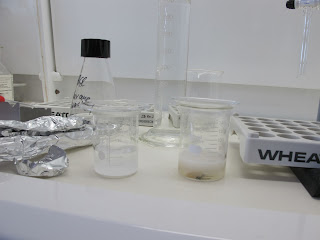In the middle of this is three days spent playing with a Chemistry set (a real one!) and another mass spec. I'm going to have to be vague here as the work I'm attempting here has only once been tried before in an unpublished piece of work in this department and obviously I'd rather not get scooped if it turns out to work. Anyway it involves lots of dissolving of my samples in acid, then playing with more chemicals to extract the solute, and all of it has to be done without any contamination, which involves a lot of washing things with yet more chemicals. Its all a bit fiddly but if it works then it may well be really interesting.
Wednesday, 15 December 2010
Chemistry Set
This week is kind of my first crucial week of my PhD. Not because anything much depends on the results I get out (in a pure data sense) but rather this week's experiments will define what exactly I'm doing for my PhD. All of my pilot studies are coming to fruition and a close at the same time! In one of those quirks of timing I've ended up with a lot of machine time over the course of this week. First up is the MAT251, our group's ageing mass spec which runs some carbon and oxygen isotopes in a fairly standard way, nothing too special about the instrument, but the particular piece of time we're looking at is pretty damn cool. On Friday I'm back on the laser, this time attached to a different mass spec called the Neptune, trying to do things that mass specs have never done before. And on Monday I have another day on the Shrimp, trying to find out whether I can link two strands of my PhD (the MAT251 part and the Laser-Neptune) into one!
So, by the end of next week, once I've managed to have a look at the results properly, I'll hopefully have worked out which parts of what I want to do work, and which ones don't. Then I can plan ahead and really get going with the actual work!
Labels:
Science,
Stalagmites
Subscribe to:
Post Comments (Atom)


No comments:
Post a Comment